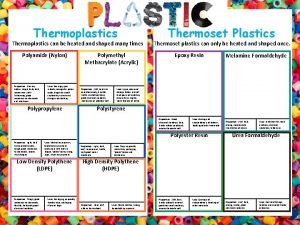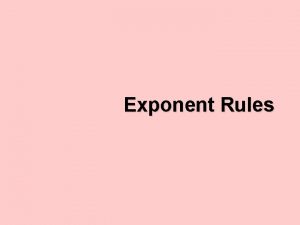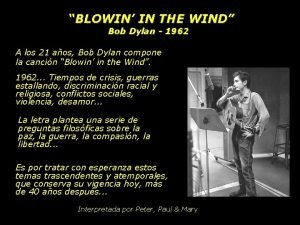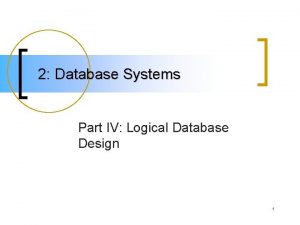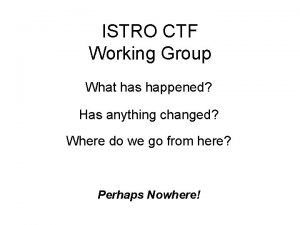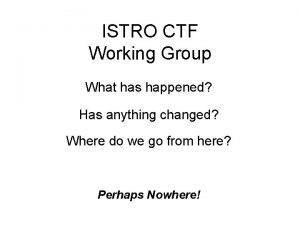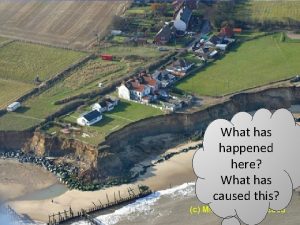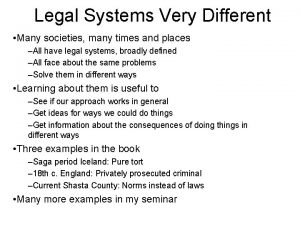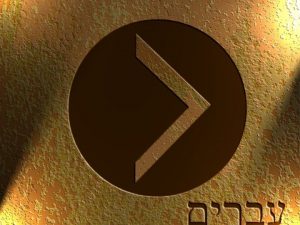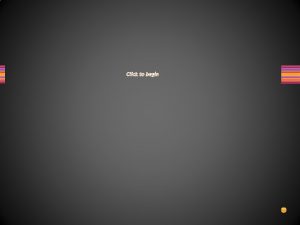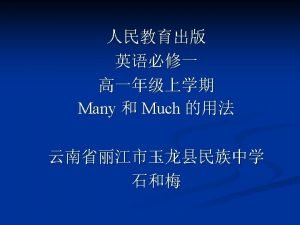How Many Times Has This Happened to You




































- Slides: 36

How Many Times Has This Happened to You?

N. O. M. S. i. Ntelligent Object-Identifying Microwave System Group 18 Nakiesa Faraji-Tajrishi Tim Miller Jared Wach

Project Goals and Objectives Automate the microwave experience Touch screen user interface Bar code scanning Internet connected More consistent cooking results Varied cooking times and temperatures Optimized instructions by wattage Push advertising to microwave user

Project Specifications and Requirements Requirement Value LCD Display Must Fit Panel Less than 60 mm x 80 mm Wi-Fi Protocol 802. 11 b Camera Frame Rate Greater than 10 frames/sec Camera Resolution At least 640 x 480 pixels Microcontroller GPIO At least 5 GPIO Microcontroller Communications I 2 C, SPI, RS 422 Onboard Storage At least 100 Mb Maximum Allotted Wattage Use Less than 1680 W, 120 V power base


Design Approach and Implementation Camera LCD Wi-Fi Microcontroller Database Power Management

Design Approach and Implementation CAMERA LCD Wi-Fi Microcontroller Database Power Management

Camera PTC-08 Serial Camera Specifications Module Size: 32 mm x 32 mm Frame Speed: 640 x 480 @ 30 fps Viewing Angle: 60 degrees Baud rate: 38400 Current Draw: 75 m. A Operating Voltage: DC +5 V Communication: 3. 3 V TTL

Camera Features NTSC video output to allow the user to align the UPC code so that the microcontroller can decode it. Once UPC code is aligned, JPEG output allows it to be captured digitally for easy processing by the microcontroller. Multiple image sizes allow us to adapt the captured image for both decoding and output to the user. Simple UART communication between the camera and the microcontroller.

Design Approach and Implementation Camera LCD Wi-Fi Microcontroller Database Power Management

Wi-Fi TI CC 3000 Specifications 802. 11 b/g integrated Wi-Fi Supports all Wi-Fi security modes Integrated IPv 4 TCP/IP stack Serial Peripheral Interface (SPI) Typical current draw of 260 m. A 3. 3 V DC

Wi-Fi Features Industry standard chip for embedded Wi-Fi applications. Heavily supported by Texas Instruments. Allows for simple ad-hoc (point-to-point) wireless configuration. Configurable from an external device. Allows for future configurations on other “smart” devices. Onboard protocol stack implemented allowing simple SPI communication between Wi-Fi chip and microcontroller.

Design Approach and Implementation Camera LCD Wi-Fi Microcontroller Database Power Management

Database Features Relational Database that uses a single field as the key to the table. Designed for high traffic. Highly used and documented for simplicity of use in the design process. URL access for querying. Free for trial use.

Design Approach and Implementation Camera LCD Wi-Fi Microcontroller Database Power Management

LCD 4 D Systems 32 PTU Specifications 3. 2” LCD-TFT display 240 x 320 with integrated 4 -wire resistive Touch Panel 2 Serial and 1 I 2 C interfaces 13 GPIO On-board SD On-board audio amplifier and speaker 155 m. A Current Draw 5 V DC

LCD Features Onboard processing system allows the user interface operation to be separate from the microcontroller. Onboard compact flash allows generous storage space for advertisements, user profiles, and custom cooking instructions. Robust set of development tools, including a visual development environment. Touch screen allows for intuitive, simple user interface.

User Interface The user interface will provide the following functions: Display the time while in standby Provide a method whereby a UPC can be scanned Provide a method for manual cooking Provide a method for the system to be configured (Wi-Fi, customized display, etc. ) Provide a method to enter and maintain use profiles Provide a method for entering and maintaining custom cooking instructions Display product and status information while cooking

User Interface Design Home Screen Default screen, user decides between automatic or manual cooking instructions Ability to access settings Time display

User Interface Design Manual Entry Allows user to set required cooking power, as designated on package Allows user to input cooking time Home Screen button to return home Back button to return to previous screen “Traditional Microwave Screen”

User Interface Design Automatic Entry User holds item up to camera to scan barcode Video feedback provided to help with alignment Once object identified, description appears on screen Start to commence cooking Override to customize cooking instructions

User Interface Design Advertising Screen The system allows for product advertisements from manufactures Allows relevant coupons to reach consumers Provides entertainment while food is cooking Video and image options, audio possibility

User Interface Design Push to Fitness Platform Food data will be collected on user profile Ability to push this data to fitness/food tracker Allows users to generate accurate food consumption data

Design Approach and Implementation Camera LCD Wi-Fi Microcontroller Database Power Management

AC Vs. DC Power Components AC DC Magnetron Microcontroller Turntable Camera Fan Motor LCD Touchscreen Lights/ Buzzer Low voltage components will not exceed 5 V DC. System controlled using 3. 3 V solid state relays. We will use existing microwave components (i. e. magnetron, turntable, fan motor).

Power Consideration Component Volts Amps Power Consumption Magnetron 4. 1 k. V 0. 171 amps 1000 W Fan 120 V 0. 7 amps 39 W Light 240 V 0. 0833 amps 20 W Turntable 120 V 0. 025 amps 3 W Buzzer 10 V 0. 010 amps 0. 1 W Controller 3. 3 V 0. 45 Amps 1. 485 W Camera 5 V 0. 075 Amps 0. 375 W Touch Screen 5 V 0. 155 Amps 0. 76 W 1. 67 Amps 1064. 72 W Total: All small appliances must be designed to operate within 15 amp circuit. Total power consumption must be less than 1800 watts.

Design Approach and Implementation Camera LCD Wi-Fi Microcontroller Database Power Management

Design Decisions : Microcontroller MSP 430 x 5 xx TM 4 C 123 x F 28 M 3 x Operating Frequency 25 MHz 80 MHz 100 MHz SPI 2 (shared) 4 4 I 2 C 1 (shared) 6 2 Serial 1 (shared) 8 5 GPIO 29 -87 12 88 Flash 512 KB 256 -512 KB(x 2) Ram 66 KB 32 KB 16 KB(x 2) Floating Point No Yes

Microcontroller TI TM 4 C 123 G Specifications ARM Cortex M 4 based So. C 256 KB Flash 32 KB SRAM 4 SSI, 4 I 2 C, 8 UARTs 43 GPIO 45 m. A current draw 3. 3 V DC

Microcontroller Requirements The system will incorporate a centralized system controller. This will handle several functions. Control the microwave magnetron. Manage and control microwave haptics. Interface with a remote database. Communicate with the user interface module. Monitor system power

UPC Capture Image Processing VGA (640 x 480) capture from the camera Grayscale Conversion Deskew Crop Example UPC

Administration Content : Budget Item Estimated Cost Actual Cost u. LCD-32 PTU $80 $106 TI CC 3000 $40 $36 PTC-08 Serial Camera $20 $40 PCB Fabrication $70 TBD Microwave $250 Free Misc. Components $15 TBD TM 4 C 123 Microcontroller $25 $13 Total: $600 > $195 - Under budget

Responsibilities Nakiesa Tim Jared Programming 4 DGL (LCD) Programming System Controller Power Management Database Management PCB Design Camera Test Wi-Fi Management Systems Integration

Progress Research Prototyping Design Percent Complete 0 10 20 30 40 50 60 70 80 90 100

Challenges Lost group member, need to appropriately redistribute work. Inexperience with Eagle schematic capture, board design and layout. Currently waiting for symbols from Texas Instruments to use in board design. Learning curve for new programming language (4 DGL) Mounting new microwave case due to redesign.

Questions?
 What do you think happened in the image?
What do you think happened in the image? Mat0022
Mat0022 Always wear your safety goggles
Always wear your safety goggles How big is the moon compared to the earth
How big is the moon compared to the earth Create once use many times
Create once use many times A rope is wrapped many times around a drum of radius 50 cm
A rope is wrapped many times around a drum of radius 50 cm Cadet class b uniform
Cadet class b uniform How many times can thermoplastics be heated and shaped
How many times can thermoplastics be heated and shaped What is moulting in silkworm
What is moulting in silkworm Much madness is divinest sense paraphrase
Much madness is divinest sense paraphrase How many times
How many times Indian flag changed how many times
Indian flag changed how many times The exponent indicates how many times
The exponent indicates how many times How many times challenge
How many times challenge How many times bob dylan
How many times bob dylan Ball a has half the mass and eight times
Ball a has half the mass and eight times Which letter e specimen has magnification of 40 times
Which letter e specimen has magnification of 40 times The titanic sank in 1912 somebody steal my bicycle
The titanic sank in 1912 somebody steal my bicycle Ever since ancient times
Ever since ancient times 7 times a day i will praise you
7 times a day i will praise you Please clean your own room
Please clean your own room Pun examples
Pun examples When i found myself in times of trouble
When i found myself in times of trouble Here is all my love it's yours no conditions
Here is all my love it's yours no conditions Perfect competition 4 conditions
Perfect competition 4 conditions Er diagram
Er diagram Unary many to many
Unary many to many Are the glue that holds the entities in the erd
Are the glue that holds the entities in the erd Unary many to many
Unary many to many Erd film
Erd film Unary many to many
Unary many to many Many-to-many communication
Many-to-many communication Sqlbi many to many
Sqlbi many to many Unary relationship database
Unary relationship database Many sellers and many buyers
Many sellers and many buyers You say you love rain
You say you love rain Eat meals that are nutritious agree or disagree
Eat meals that are nutritious agree or disagree







